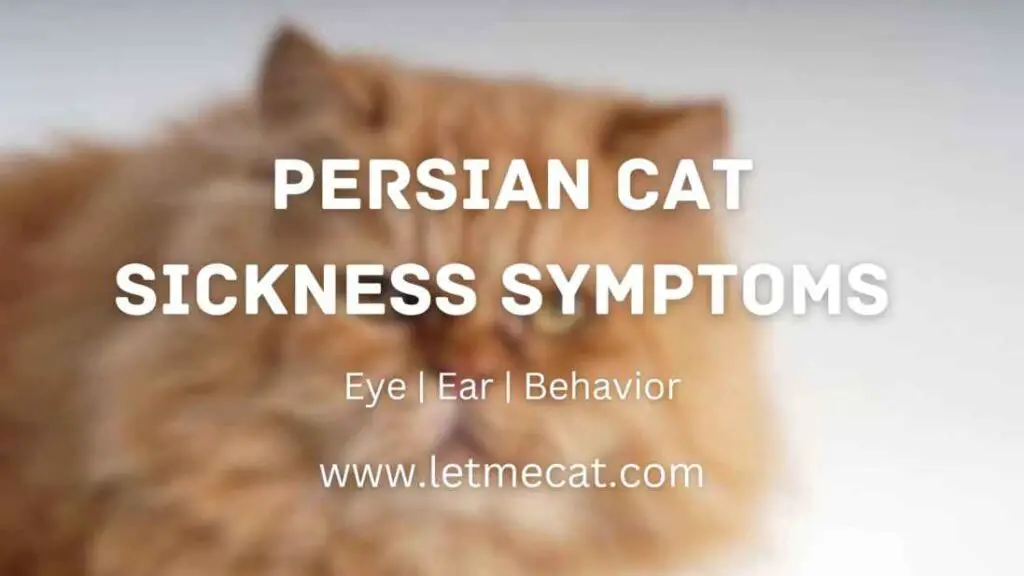In this article, we’ll explore the common Persian cat sickness symptoms. As a responsible owner, it’s crucial to be aware of these symptoms and provide timely care for your beloved pet.
Let’s jump right into the world of Persian cat health and learn how to keep your furry friend in top shape.
Common Sicknesses
1. Respiratory Issues
One of the common health problems Persian cats may face is respiratory issues. Their short, flat noses can make it harder for them to breathe properly, leading to conditions like brachycephalic airway syndrome.
Symptoms of respiratory problems in Persian cats include:
- Wheezing
- Snoring
- Difficulty breathing
- Coughing
If you notice these signs, it’s crucial to consult a veterinarian for a proper diagnosis and treatment.
2. Digestive Problems
Persian cats are also susceptible to digestive problems. Their sensitive stomachs may react negatively to certain foods, resulting in:
- Diarrhea
- Vomiting
- Constipation
Additionally, hairballs can be a recurring issue for Persian cats due to their long fur. Providing a balanced diet and grooming your cat regularly can help prevent digestive issues. If your Persian cat experiences persistent digestive problems, consult a veterinarian for guidance.
3. Skin Conditions
The long, dense coat of Persian cats requires regular grooming to maintain their health and prevent skin problems. Neglecting grooming can lead to issues like:
- Matting
- Excessive shedding
- Skin infections
Signs of skin conditions in Persian cats include redness, itchiness, hair loss, or the presence of sores. Proper grooming practices, such as regular brushing and bathing, can significantly reduce the risk of skin problems.
Behavioral Changes
Apart from physical ailments, Persian cats may also exhibit behavioral changes when they are unwell. It’s essential to pay attention to any unusual behaviors your cat displays, as they can indicate underlying health issues.
1. Lethargy
One common behavioral change seen in sick Persian cats is lethargy or a lack of energy. If your usually active and playful cat becomes unusually sluggish and spends more time sleeping or resting, it could be a sign of an underlying health problem.
Monitor your cat’s activity levels and consult a veterinarian if you notice prolonged lethargy.
2. Changes in Appetite
A significant change in appetite can also indicate sickness in Persian cats. If your cat suddenly loses interest in food or exhibits a decreased appetite for an extended period, it could be a sign of an underlying health condition.
Conversely, an increase in appetite can also be a cause for concern. Monitor your cat’s eating habits and consult a veterinarian if you observe significant changes.
3. Aggression
Behavioral changes may also manifest as increased aggression in Persian cats. If your typically docile and friendly cat displays sudden aggression or becomes irritable and easily provoked, it may be a sign of discomfort or pain.
Consult a veterinarian to rule out any underlying medical conditions that may be causing this change in behavior.
Eye and Ear Problems
Persian cats are prone to certain eye and ear problems that can affect their overall well-being. Regular monitoring and proper care are crucial to prevent complications.
1. Conjunctivitis
Conjunctivitis, or pink eye, is a common eye condition that can affect Persian cats. Symptoms include redness, swelling, discharge, and excessive blinking.
Regularly inspect your cat’s eyes and seek veterinary assistance if you notice any signs of conjunctivitis. Prompt treatment can prevent the condition from worsening and causing discomfort to your pet.
2. Ear Infections
Persian cats have long, floppy ears that require regular cleaning and care. Failure to maintain proper ear hygiene can result in ear infections. Signs of ear infections in Persian cats include:
- Frequent scratching of the ears
- Shaking of the head
- Discharge
- Foul odor
Regularly clean your cat’s ears and seek veterinary advice if you suspect an ear infection.
Conclusion
Being aware of the potential sickness symptoms in Persian cats is crucial for every owner. By recognizing the signs early on, you can provide timely veterinary care and ensure the well-being of your beloved pet.
Remember to monitor your Persian cat’s respiratory health, digestive system, skin condition, and behavior, as well as their eyes and ears. Regular grooming, a balanced diet, and prompt veterinary attention will help keep your Persian cat healthy and happy.
That’s all for this article. Thank you so much for reading it.




Pingback: Diseases Caused By Persian Cats To Humans [Guide] - Let Me Cat
Pingback: Persian Cat Price In Manila: Factors, Costs, Tips - Let Me Cat